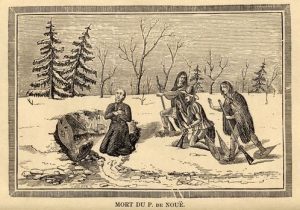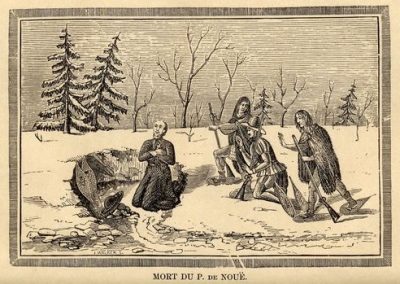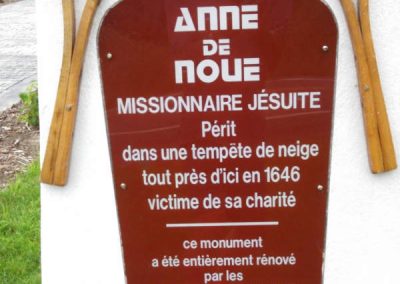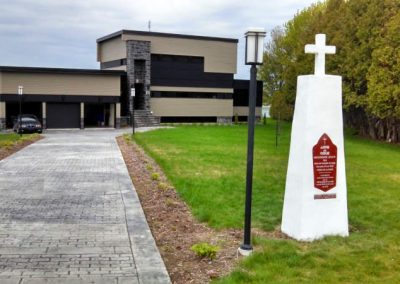The heroic death of Father Anne de Nouë
Youth:
Anne de Nouë was born on August 7, 1587 near Reims, France. From a noble family, Anne de Nouë spent several years at the court of Henri IV where M. de La Vieuville had taken him into his service as a page boy (he was nicknamed “the beautiful page”). Later, he was an officer of the King’s Chamber. In September 1612, he entered the novitiate of the Parisian Jesuits, and studied in Paris, where he served as prefect during his theological studies (1618-1622), then in La Flèche and Nevers. After two years as minister of the college of Bourges (1622-1624), he came to Canada in 1626. He wintered in Huronia (Huron missions) with Father de Brébeuf, then went among the Montagnais; but, although he had a lively intelligence, he was not able to learn the languages nor to get used to the way of life of the First Nations. On the other hand, he was a skilled fisherman, which enabled him to feed the community and his friends during the distress of 1627-1628 in Quebec.
Back in France (1629-1632), he was a minister at the colleges of Amiens and Orleans before returning to Canada to take care of the many workers at the Quebec residence. He remained there until 1642, when he left for Trois-Rivières.
Visit of the Beaupré coast:
In 1633, Father Anne de Nouë visited the future coast of Sainte-Anne-de-Beaupré for the first time, following a native who asked him to come and visit his camp located toward Cap Tourmente. “Father Anne de Nouë had a body too weak for his great soul; he could not cover the distance between Quebec City and Cap Tourmente in one day; he had to stop and sleep under the stars, in a presbytery made of snow, with the sky as his blanket; a piece of boiled eel, washed down with a cup of melted snow, made up the menu for his supper” (c.f. La Bonne Sainte Anne, page 32).
“The next day, the missionary was able to reach the end of his mission. The overflowing joy that his visit brought to these poor children of the woods made him quickly forget his sorrows; kneeling in the snow, hands joined, head uncovered, eyes in heaven, he blessed the Divine Redeemer for having chosen him to bring to these souls the joys of religion” (c.f. La Bonne Sainte Anne, page 32).
“The savages set to work to give the Black Robe the best welcome. One puts water in the boiler, or rather snow; a hunter has just captured two beavers; they are torn to pieces, thrown into the boiler, without washing them for fear of losing the fat. “It is very good, all that,” say the Indians, “Father, tell us about your beautiful Saint, it is even better” (c.f. La Bonne Sainte Anne, page 33)
“Because of his name, Father Anne de Nouë has a hard time convincing them that he is not the Good Saint Anne himself. “Since she is even better than you,” they replied, “we will always pray to her, and you will see in your next visit if we have hurt her!” (c.f. La Bonne Sainte Anne, page 33).
 Tragic death:
Tragic death:
On January 30, 1646, he left Trois-Rivières to administer the sacraments to the soldiers of the Sorel garrison. Surprised by the storm, he lost his way in the islands of Lake Saint-Pierre, and was not found until the following February 2, nearly four leagues above the Richelieu. A soldier of the fort who, with two Hurons, had gone in search of him, saw at the cape called Massacre, a league higher than Richelieu, a place where he had rested.
Three leagues further on, opposite the Plate Island and the mainland, between two small streams, they found his body frozen on the open ground, having emptied the snow in a circle; his hat and snowshoes were beside him, he was bent over the edge of the raised snow, his eyes were open, looking up to the sky and his arms were crossed over his chest.
Sources:
- BÉLANGER, Georges, La Bonne Sainte Anne, au Canada et à Beaupré, pages 32 and 33
- www.biographi.ca/fr/bio/noue_anne_de_1F.html



